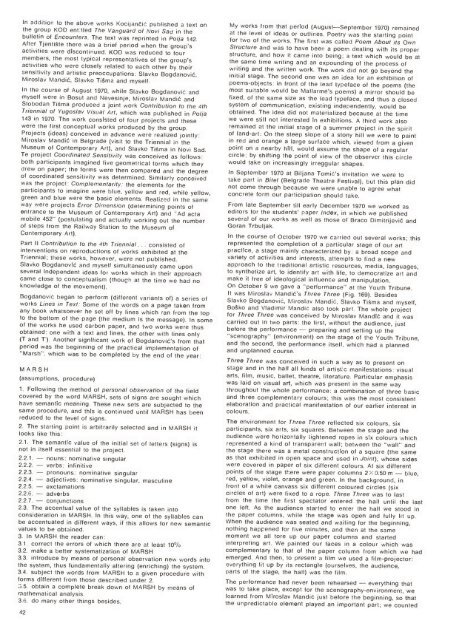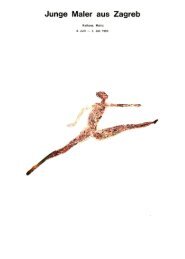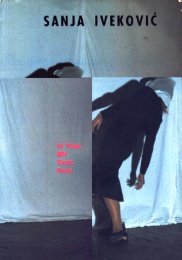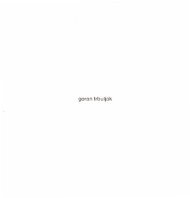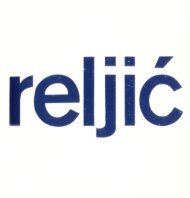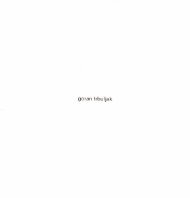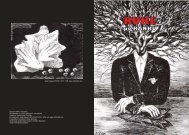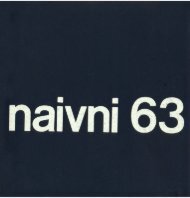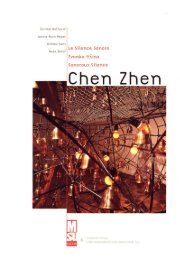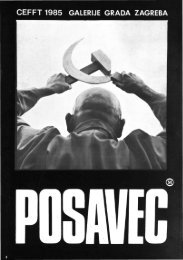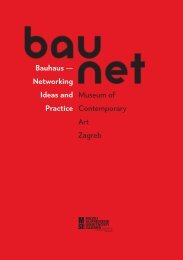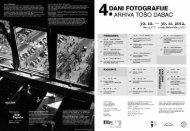The New Art Practice in Yugoslavia, 1966-1978
The New Art Practice in Yugoslavia, 1966-1978
The New Art Practice in Yugoslavia, 1966-1978
- TAGS
- practice
- yugoslavia
- www.msu.hr
You also want an ePaper? Increase the reach of your titles
YUMPU automatically turns print PDFs into web optimized ePapers that Google loves.
In addition to the above works Kocijani published a text on<br />
the group KOD enttled <strong>The</strong> Vanguard of Novi Sad <strong>in</strong> the<br />
bullet<strong>in</strong> of Encounters. <strong>The</strong> text was repr<strong>in</strong>ted <strong>in</strong> Polja 142.<br />
After Tjentite there was a brief period when the group's<br />
activities were discont<strong>in</strong>ued. KOD was reduced to four<br />
members, the most typical representatives of the group's<br />
activities who were closely related to each other by their<br />
sensitivity and artistic preoccupations: Slavko Bogdanovi,<br />
Miroslav Mandi, Slavko Tima and myself.<br />
In the course of August 1970, while Slavko Bogdanovi and<br />
myself were <strong>in</strong> Bosut and Neves<strong>in</strong>je, Miroslav Mandi and<br />
Slobodan Tima produced a jo<strong>in</strong>t work Contribution to the 4th<br />
Triennial of Yugoslav Visual <strong>Art</strong>, which was published <strong>in</strong> Polja<br />
143 <strong>in</strong> 1970. <strong>The</strong> work consisted of four projects and these<br />
were the first conceptual works produced by the group.<br />
Projects (ideas) conceived <strong>in</strong> advance were realized jo<strong>in</strong>tly:<br />
Miroslav Mandi <strong>in</strong> Belgrade (visit to the Triennial <strong>in</strong> the<br />
Museum of Contemporary <strong>Art</strong>), and Slavko Tima <strong>in</strong> Novi Sad.<br />
Te project Coord<strong>in</strong>ated Sensitivity was conceived as follows:<br />
both participants imag<strong>in</strong>ed five geometrical forms which they<br />
drew on paper; the forms were then compared and the degree<br />
of coord<strong>in</strong>ated sensitivity was determ<strong>in</strong>ed. Similarly conceived<br />
was the project: Complementarily: the elements for the<br />
participants to imag<strong>in</strong>e were blue, yellow and red, while yellow,<br />
green and blue were the basic elements Realized <strong>in</strong> the same<br />
way were projects Error Dimension (determ<strong>in</strong><strong>in</strong>g po<strong>in</strong>ts of<br />
entrance to the Museum of Contemporary <strong>Art</strong>) and "Ad acta<br />
mobile 452" (postulat<strong>in</strong>g and actually work<strong>in</strong>g out the number<br />
of steps from the Railway Station to the Museum of<br />
Contemporary <strong>Art</strong>).<br />
Part II Contribution to the 4th Triennial ... consisted of<br />
<strong>in</strong>terventions on reproductions of works exhibited at the<br />
Triennial; these works, however, were not published.<br />
Slavko Bogdanovi and myself simultaneously came upon<br />
several <strong>in</strong>dependent ideas for works which <strong>in</strong> their approach<br />
came close to conceptualism (though at the time we had no<br />
knowledge of the movement).<br />
Bogdanovi began to perform (different variants of) a series of<br />
works L<strong>in</strong>es <strong>in</strong> Text: Some of the words on a page taken from<br />
any book whatsoever he set off by l<strong>in</strong>es which ran from the top<br />
to the bottom of the page (the medium is the message). In some<br />
of the works he used carbon paper, and two works were thus<br />
obta<strong>in</strong>ed: one with a text and l<strong>in</strong>es, the other with l<strong>in</strong>es only<br />
(T and T'). Another significant work of Bogdanovi's from that<br />
period was the beg<strong>in</strong>n<strong>in</strong>g of the practical implementation of<br />
"Marsh", which was to be completed by the end of the year:<br />
MARSH<br />
(assumptions, procedure)<br />
1. Follow<strong>in</strong>g the method of personal observation of the field<br />
covered by the word MARSH, sets of signs are sought which<br />
have semantic mean<strong>in</strong>g. <strong>The</strong>se new sets are subjected to the<br />
same procedure, and this is cont<strong>in</strong>ued until MARSH has been<br />
reduced to the level of signs.<br />
2 <strong>The</strong> start<strong>in</strong>g po<strong>in</strong>t is arbitrarily selected and <strong>in</strong> MARSH it<br />
looks like this:<br />
2.1. <strong>The</strong> semantic value of the <strong>in</strong>itial set of letters (signs) is<br />
not <strong>in</strong> itself essential to the project.<br />
2.2.1. nouns: nom<strong>in</strong>ative s<strong>in</strong>gular<br />
2.2.2. verbs: <strong>in</strong>f<strong>in</strong>itive<br />
2.2.3. pronouns: nom<strong>in</strong>ative s<strong>in</strong>gular<br />
2.2.4. adjectives: nom<strong>in</strong>ative s<strong>in</strong>gular, mascul<strong>in</strong>e<br />
2.2.5. exclamations<br />
2.2.6. adverbs<br />
2.2.7. conjunctions<br />
2.3. <strong>The</strong> accentual value of the syllables is taken <strong>in</strong>to<br />
consideration <strong>in</strong> MARSH. In this way, one of the syllables can<br />
be accentuated <strong>in</strong> different ways, if this allows for new semantic<br />
values to be obta<strong>in</strong>ed.<br />
3. In MARSH the reader can:<br />
3.1. correct the errors of which there are at least 100/0<br />
3.2. make a better systematization of MARSH<br />
3.3. <strong>in</strong>troduce by means of personal observation new words <strong>in</strong>to<br />
the system, thus fundamentally alter<strong>in</strong>g (enrich<strong>in</strong>g) the system.<br />
3.4. subject the words from MARSH to a given procedure with<br />
forms different from those described under 2.<br />
3.5. obta<strong>in</strong> a complete break down of MARSH by means of<br />
mathematical analysis.<br />
3.6. do many other th<strong>in</strong>gs besides.<br />
42<br />
My works from that period (AugustSeptember 1970) rema<strong>in</strong>ed<br />
at the level of ideas or outl<strong>in</strong>es. Poetry was the start<strong>in</strong>g po<strong>in</strong>t<br />
for two of the works. <strong>The</strong> first was called Poem About its Own<br />
Structure and was to have been a poem deal<strong>in</strong>g with its proper<br />
structure, and how it came <strong>in</strong>to be<strong>in</strong>g; a text which would be at<br />
the same time writ<strong>in</strong>g and an expound<strong>in</strong>g of the process of<br />
writ<strong>in</strong>g and the written work. <strong>The</strong> work did not go beyond the<br />
<strong>in</strong>itial stage. <strong>The</strong> second one was an idea for an exhibition of<br />
poems-objects, <strong>in</strong> front of the lead typeface of the poems (the<br />
most suitable would be Mallarma's poems) a mirror should be<br />
fixed, of the same size as the lead typeface, and thus a closed<br />
system of communication, exist<strong>in</strong>g <strong>in</strong>dependently, would be<br />
obta<strong>in</strong>ed. <strong>The</strong> idea did not materialized because at the time<br />
we were still not <strong>in</strong>terested <strong>in</strong> exhibitions. A third work also<br />
rema<strong>in</strong>ed at the <strong>in</strong>itial stage of a summer project <strong>in</strong> the spirit<br />
of land-art: On the steep slope of a stony hill we were to pa<strong>in</strong>t<br />
<strong>in</strong> red and orange a large surface which, viewed from a given<br />
po<strong>in</strong>t on a nearby hill, would assume the shape of a regular<br />
circle: by shift<strong>in</strong>g the po<strong>in</strong>t of view of the observer this circle<br />
would take on <strong>in</strong>creas<strong>in</strong>gly irreggular shapes.<br />
In September 1970 at Biljana Tomi's <strong>in</strong>vitation we were to<br />
take part <strong>in</strong> Bitef (Belgrade <strong>The</strong>atre Festival), but this plan did<br />
not come through because we were unable to agree what<br />
concrete form our participation should take.<br />
From late September till early December 1970 we worked as<br />
editors for the students' paper Index, <strong>in</strong> which we published<br />
several of our works as well as those of Braco Dimitrijevi and<br />
Goran Trbuljak.<br />
In the course of October 1970 we carried out several works; this<br />
represented the completion of a particular stage of our art<br />
practice, a stage ma<strong>in</strong>ly characterized by: a broad scope and<br />
variety of activities and <strong>in</strong>terests. attempts to f<strong>in</strong>d a new<br />
approach to the traditional artistic resources, media, languages,<br />
to synthetize art, to identify art with life, to democratize art and<br />
make it free of ideological <strong>in</strong>fluence and manipulation.<br />
On October 9 we gave a "performance" at the Youth Tribune.<br />
It was Miroslav Mandi's Three Three (Fig. 1691. Besides<br />
Slavko Bogdanovi, Miroslav Mandi, Slavko Tima and myself,<br />
Boko and Vladimir Mandi also took part. <strong>The</strong> whole project<br />
for Three Three was conceived by Miroslav Mandi and it was<br />
carried out <strong>in</strong> two parts: the first, without the audience, just<br />
before the performance prepar<strong>in</strong>g and sett<strong>in</strong>g up the<br />
"scenography" (environment) on the stage of the Youth Tribune,<br />
and the second, the performance itself, which had a planned<br />
and unplanned course.<br />
Three Three was conceived <strong>in</strong> such a way as to present on<br />
stage and <strong>in</strong> the hall all k<strong>in</strong>ds of artistc manifestations: visual<br />
arts, film, music, ballet, theatre, literature. Particular emphasis<br />
was laid on visual art, which was present <strong>in</strong> the same way<br />
throughout the whole performance: a comb<strong>in</strong>ation of three basic<br />
and three complementary colours: this was the most consistent<br />
elaboration and practical manifestation of our earlier <strong>in</strong>terest <strong>in</strong><br />
colours.<br />
<strong>The</strong> environment for Three Three reflected six colours, six<br />
participants, six arts, six squares. Between the stage and the<br />
audience were horizontally tightened ropes <strong>in</strong> six colours which<br />
represented a k<strong>in</strong>d of transparent wall; between the "wall" and<br />
the stage there was a metal construction of a square (the same<br />
as that exhibited <strong>in</strong> open space and used <strong>in</strong> Jo<strong>in</strong>t), whose sides<br />
were covered <strong>in</strong> paper of six different colours. At six different<br />
po<strong>in</strong>ts of the stage there were paper columns 2',(0.50 m blue,<br />
red, yellow, violet, orange and green. In the background, <strong>in</strong><br />
front of a white canvass six different coloured circles (six<br />
circles of art) were fixed to a rope. Three Three was to last<br />
from the time the first spectator entered the hall until the last<br />
one left. As the audience started to enter the hall we stood <strong>in</strong><br />
the paper columns, while the stage was open and fully lit up.<br />
When the audience was seated and wait<strong>in</strong>g for the beg<strong>in</strong>n<strong>in</strong>g,<br />
noth<strong>in</strong>g happened for five m<strong>in</strong>utes. and then at the same<br />
moment we all tore up our paper columns and started<br />
<strong>in</strong>terpret<strong>in</strong>g art. We pa<strong>in</strong>ted our faces <strong>in</strong> a colour which was<br />
complementary to that of the paper column from which we had<br />
emerged. And then, to present a film we used a film-projector:<br />
everyth<strong>in</strong>g lit up by its rectangle (ourselves, the audience,<br />
parts of the stage, the hall) was the film.<br />
<strong>The</strong> performance had never been rehearsed everyth<strong>in</strong>g that<br />
was to take place, except for the scenography-environment, we<br />
learned from Miroslav Mandi just before the beg<strong>in</strong>n<strong>in</strong>g, so that<br />
the unpredictable element played an important part: we counted


